A record worth its salt
Fifty years ago Donald Campbell’s outdated Bluebird defied the jet age by setting a new Land Speed Record. The scene remains one of the most inhospitable places in the world
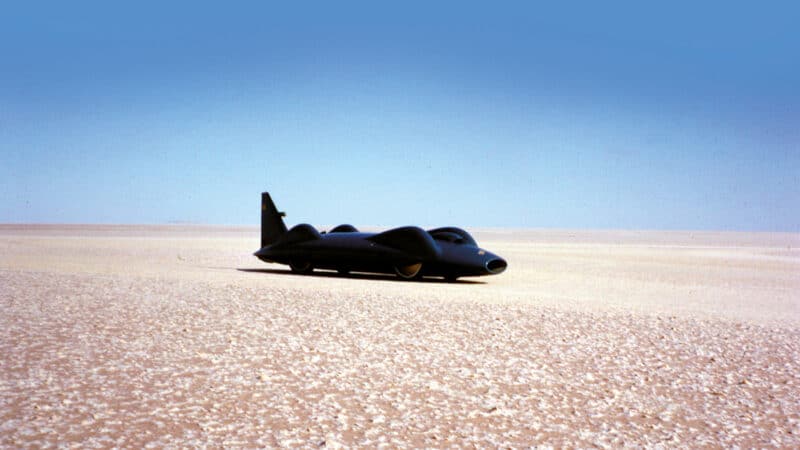
Heritage Image Partnership Ltd / Alamy Stock Photo
Taken from Motor Sport, September 2014, A record worth its salt
It is 50 years since Donald Campbell broke the world land speed record on Lake Eyre in South Australia with his gas-turbine car Bluebird. On July 17 1964 he recorded the incredible speed of 403.100mph in a wheel-driven car, before the age of jet and rocket propulsion took over. But the bald facts do not do Campbell’s achievement justice, as I found out when I went to visit Lake Eyre to discover what it would have been like all those years ago.
It seems strange that the LSR should be set on a lake, but this is one of the largest lakes in the world. The Lake Eyre Basin covers 1.2 million square miles, one sixth of the total of the vast continent of Australia. Yet because it is such a dry, arid country the lake is rarely full, and for much of the time it is dry. This enormous parched level area of salt was seen for the first time by a European, Edward John Eyre, in 1840. Here at the lowest point in Australia, 15m below sea level, water covers the lake only every seven or eight years, and it has only been at capacity three times since Eyre first stumbled upon it. Even today in a modern 4WD vehicle it’s an adventure to access the very heart of Terra Australis, the great Southern Land.
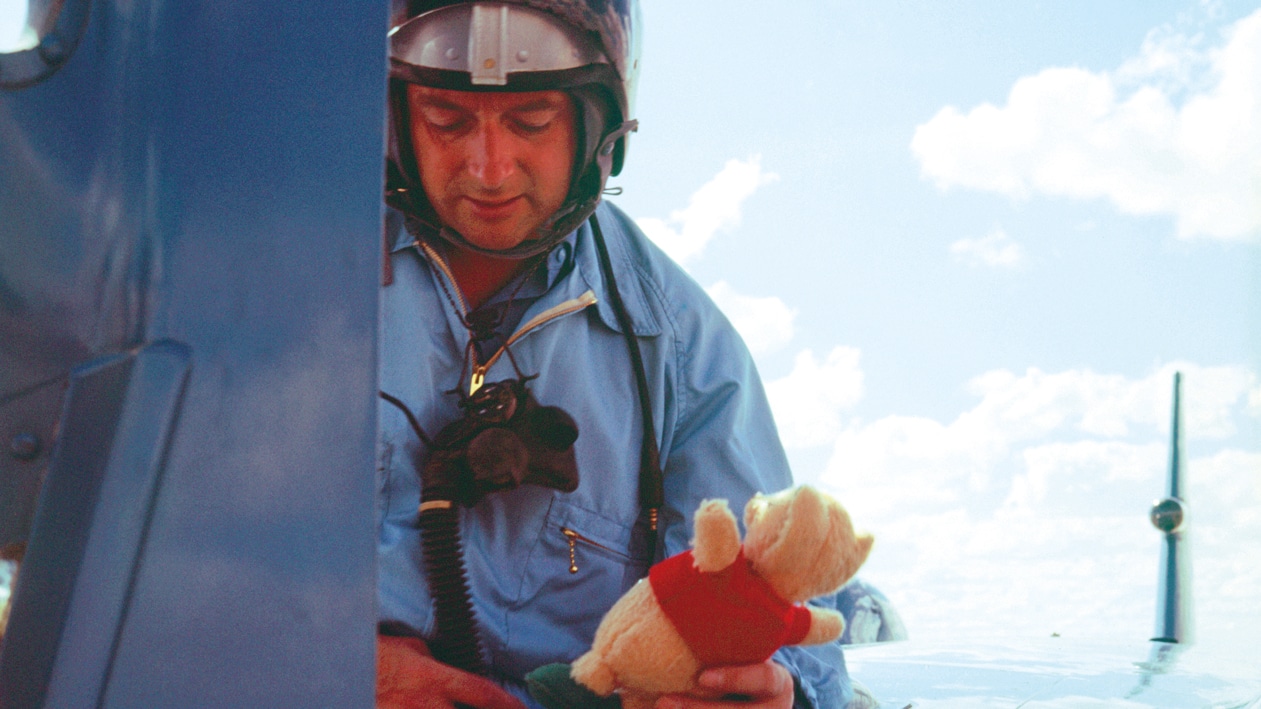
Starting from Adelaide we headed north toward Muloorina, the homestead where Campbell and his entourage put up half a century ago. Turning off the single lane Sturt Highway and crossing the South Flinders Ranges, we emerged onto the flat plain below, where a few emu, sheep, cattle and wild horses are the only life among the abandoned houses. It had been raining since we left Adelaide and, as we reached the end of the sealed road, some 600km further north, it was still raining. The unsealed road, made up of the ochre desert earth, was wet and slippery as we slithered another 48 miles to Marree. Ahead, however, the 31-mile track to Muloorina was closed due to the rains. We turned back to stay at the Marree Hotel, built in 1883 when the narrow-gauge railway reached the town. Here we learnt that the road behind us had also been closed. It was the 21st Century and we were stranded – no way in or out, no mobile phone connection, in a place where you can only drink bottled water. Luckily they also had some beer…
Next day it continued to rain and the ‘roads’ remained closed. This was what Campbell and his team experienced on their first visit – plans ruined by steady rain in one of the driest places on earth. The hotel was quite crowded with other travellers stuck in this ‘town’ at the crossroads of three desert tracks, once an important staging point for livestock transport but now sidelined. Just 60 people live here, one third Australian, one third Aboriginal and one third Afghan, descendants of the cameleers who provided transport in the early days.
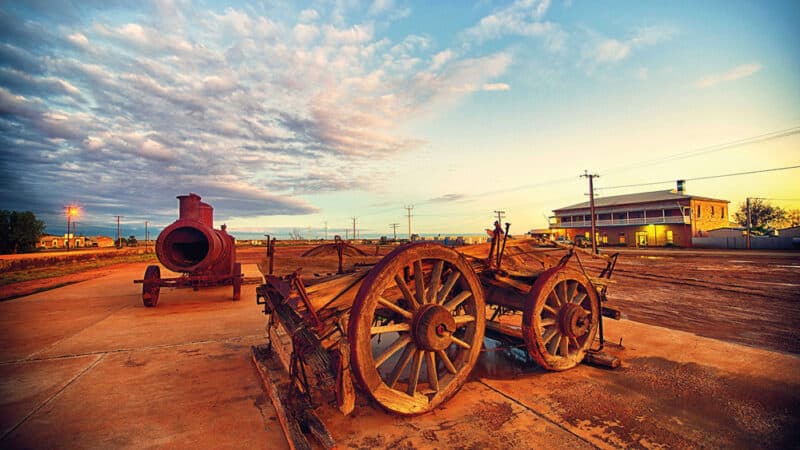
The Marree Hotel stands as pretty much the last bastion of comfort in this area of the South Australian outback
Paul Marshall 2014
The main street was a deluge of mud sucking at our boots as we explored the derelict trains, the derelict mosque (Australia’s oldest) and the cemetery, the town’s dead population split like the living into three groups. We discovered the Lake Eyre Yacht Club, one eccentric man’s folly for sailing on the lake when it held some water. It had water now, no doubt – but no means of accessing it by land.
If not by land then we could charter a plane. But the nearest was at William Creek, 200km away, and we would have to wait until it had dropped supplies to those cut off by floods. In this dreary outback town, with a monotonous blanket of cloud overhead, it was an existence of frustration, boredom and flies. The flies were everywhere, though of Campbell and Bluebird little evidence, even though Marree was an important town for the project, where the men would drink or collect supplies and Campbell’s wife – the singer Tonia Bern – even gave a charity concert. A small picture of the car in the very top corner of a mural at the hotel and a fly-blown copy of John Pearson’s Bluebird and the Dead Lake (an account of the events of 1964, which I found at the general store) were the sum total.
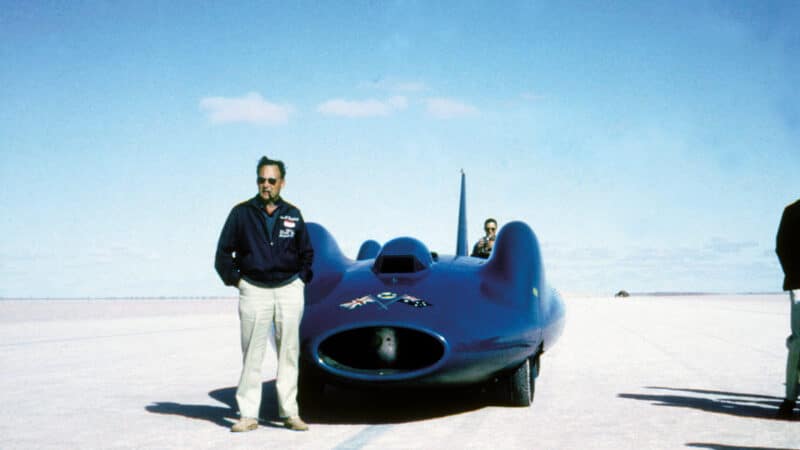
Campbell poses with Bluebird on the Lake Eyre salt. It was a mighty effort to even get there. Previous spread, right: Campbell holds the team’s mascot Mr Whoppit, a stuffed bear
And yet through my frustration of not being able to reach Muloorina, there came to me the realisation that I was experiencing exactly what Donald Campbell and the rest of the Bluebird team had endured. Campbell had first flown over the Lake in 1961, scouting for a new record venue after a disastrous 1960 attempt on the Bonneville Salt Flats in Utah which had nearly killed him. At Lake Eyre he had found mile upon mile of flat salt with no one else there to cross his course. But in 1961 there had been no rain. In fact there had been very little rain for seven years until Campbell arrived in April 1963 – but after two months of downpour the attempt was postponed until 1964. A huge amount of preparation work had been carried out to get Bluebird onto Lake Eyre. The Australian Army had built a causeway from the desert across the muddy ooze on the lake’s edge to the salt, and this access point was another hour’s drive from Muloorina. I was beginning to understand the challenge that Campbell and the 150-odd support crew must have had to overcome just to get Bluebird into position, let alone carry out two runs of over a mile in length at more than 400mph.
When Campbell returned in April 1964 it rained again, and it was not for another three months that the record was finally broken.
As he sat there waiting and counting the ever-increasing financial costs that the delays incurred it must have been incredibly stressful – like watching a taxi meter click over when stuck in traffic and short of cash.
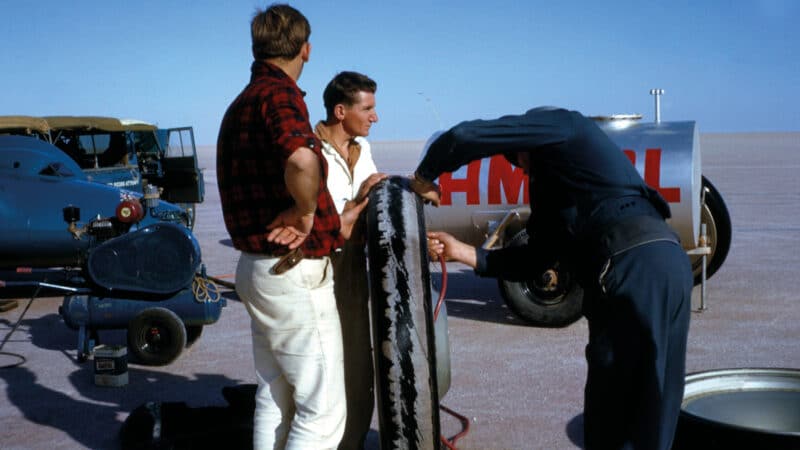
Mechanics inflate one of Bluebird’s tyres in 1964
Getty Images
Just as it had rained in April 1964 so it was in April 2014. The flat and uninspiring landscape was not the desert of heat and light Campbell or I was expecting, but a soggy morass of damp grey and flies. At last our plane arrived. We needed to see Muloorina and more importantly Lake Eyre, where Campbell had executed his heroic last-ditch run. In much the same way that Campbell must have switched from lassitude and torpor to steel himself for practice runs at speeds never before exceeded in Australia to test the surface of the much softer than anticipated salt, so too did we switch from our Marree languor to suddenly being at 500 feet at 150mph. After days of twiddling our thumbs, in just a few minutes we were above the homestead of Muloorina, where Campbell, his mechanic Leo Villa who had served his father Sir Malcolm before him, and his lieutenant and designer Ken Norris, had patiently lived for so many weeks as they waited for the sun to bake the salt hard enough to take Bluebird’s weight and traction through its four driven wheels. What a desolate place among the flat vista that spread and spread before us. We circled a few times, spotting the graders that had helped level the course on the Lake and the ‘Old Blitz’ truck, which had carried Bluebird from Muloorina to the Lake, now consigned to the metallic graveyards littering the homestead. But we were unable to land at Muloorina; the red mud strip then-owner Elliot Price originally marked out with desiccated camel bones was too wet.
“Campbell had brought the fastest car ever built across the world to one of the most desolate, inaccessible and inhospitable places on earth”
We flew on above Lake Eyre and that is when the enormity of Campbell’s undertaking really struck home. He had brought the fastest car ever built from the other side of the world to one of the most desolate, inaccessible, inhospitable and loneliest places on our planet. The logistics were incredible, the effort phenomenal, and yet on a surface that turned out to be quite unreliable he broke the world Land Speed Record. He alone stepped into the cockpit and shot off into the white void. How on earth had they managed it, here? How had he managed it, here? We turned and headed for Marree. The road to Muloorina was still closed but the road heading south to civilisation was open once again. We collected our gear and headed south.
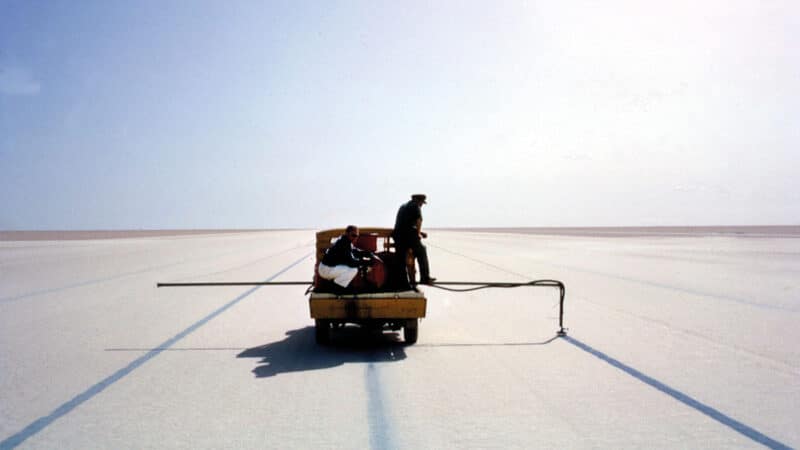
One of the trucks used to mark the course on the salt
Heritage Image Partnership Ltd / Alamy Stock Photo
Back on the real road we stopped at the Prairie Hotel in Parachilna, another 19th- century pub on the old train line, where we were pointed towards John Teague at the service station at Hawker in the foothills of the Flinders. John turned out to be a mine of information; he even had a block of salt that Elliot Price, dubbed ‘the King of Muloorina’ by Campbell, had sold to his father after the record. Better still, he remembered many of the local men and women who worked on the project a lifetime ago, including Bill Mitchell, the manager at Muloorina, and ‘Blue’ Hughes. Unfortunately Bill was sick and not receiving visitors, but it was in meeting ‘Blue’, halfway home, that we came the closest to the spirit of Bluebird in 1964.
‘Blue’ (called thus because of his red hair, in true Aussie style) is now 84 and his wife Lorna 80. As they sat in their bungalow, they told me of the excitement of hosting the members of the Bluebird project on the homestead where they lived and worked. ‘Blue’ drove the grader to level the salt, and the truck in which Bluebird was delivered to the Lake; Lorna cooked and washed for the men billeted in their home. It was a hard and in many ways monotonous way of life, they said, and the arrival of Bluebird was a welcome change from routine. They spoke of Donald and his wife Tonia as though it was yesterday: “Face to face they were just the same as you or me, and very friendly.” They talked of the other characters involved including Andrew Mustard, with whom Campbell did not see eye to eye, and Pat Crowe the photographer, both of whom had become life-long friends. What an incredible experience to talk with these two octogenarians who had both been on the salt for the record run, and to see Lorna’s face light up as it must have done when she was just a young woman as she described Bluebird: “It was just so fast!” There was nothing else to be said. I had found Donald Campbell and Bluebird after all.
“By the time he broke the record, both Campbell and Bluebird were regarded as dinosaurs”
By the time Campbell broke the world LSR on Lake Eyre, he and his car were already regarded as dinosaurs. With its engine driving the wheels, Bluebird was old school and old technology. Even his unique feat of also breaking the water record that same year, reaching 276mph on Lake Dumbleyung, raised lukewarm applause. The 1960s were the jet age, a time of space exploration, and Donald’s achievements, while acknowledged, were never regarded in the same light as those of his father, who took the LSR nine times and the WSR four, or of those inter-war heroes Segrave, Parry Thomas, Keech, Eyston and Cobb.
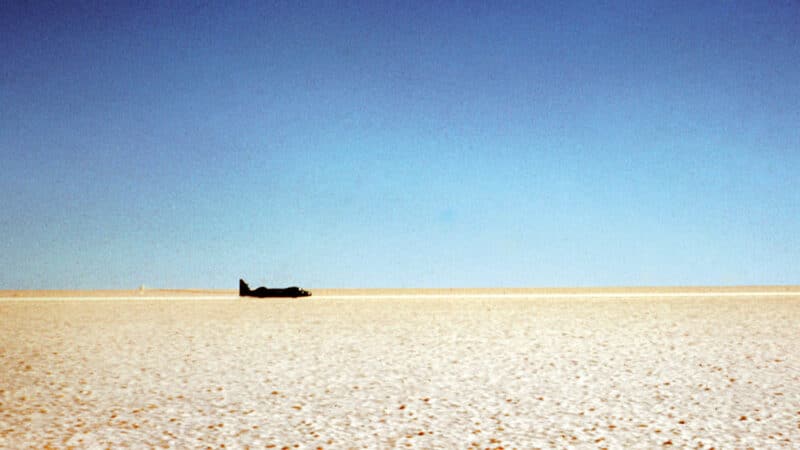
Bluebird descends from full flight with the help of a parachute
Within months Campbell’s hard-won record was blown away by jet-propelled cars, new records being set five times by Americans Tom Green, Craig Breedlove and Art Arfons, working up to 536.710mph to put Campbell completely in the shade. In 1965 Breedlove extended the record to 600.601mph, while Garry Gabelich in The Blue Flame hit 622.407mph five years later. It was 13 years before Richard Noble took Thrust 2 to 633.468mph – and another 14 until Squadron Leader Andy Green went supersonic in Thrust SSC, touching Mach 1.0175 (763.035mph). Since then the record has stood proudly at this mark, but once again we seem to be entering a period of new record attempts as several syndicates around the world look to break the 1000mph barrier.
Among those endeavouring to set a new record are Aussie Invader 5R led by Ross McGlashan, and North American Eagle, a combined USA/Canada syndicate that has already made 44 test runs. But it is perhaps the British, holders of the LSR for 31 years, who are the most advanced in this new quest. With Andy Green on board, Bloodhound SSC seeks to inspire a new generation with fresh enthusiasm for science, technology, engineering and mathematics on its way to 1000mph.
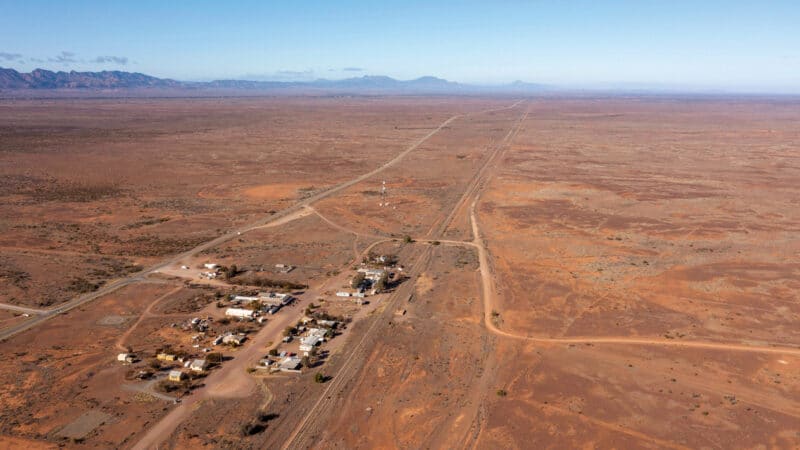
Literally on a road to nowhere. The tiny town of Parachilna, where Campbell’s team stayed and recruited local help
Heritage Image Partnership Ltd / Alamy Stock Photo
The venue, Hakskeen Pan in South Africa’s Northern Cape, is rather closer to Verneuk Pan, location of Sir Malcolm Campbell’s 1929 runs where his 218.45mph tyre tracks remain visible still, than to Lake Eyre.
It seems unlikely that it will present Noble’s team with as many problems as Donald Campbell had to battle in that sodden, desolate and all too wet lake in 1964.
